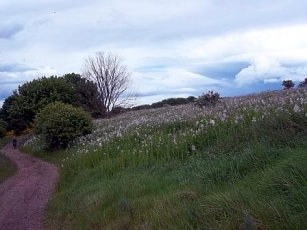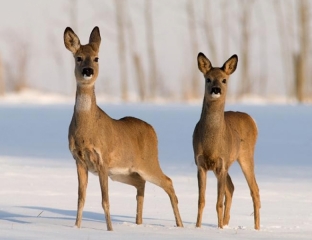Three Cheers for Aberdeen City Council! The Cull is on Hold! Or so you might think if you glanced at a headline in tonight’s Evening Express. Voice’s Suzanne Kelly writes.
Several people on the anti-cull e-mailing lists have seen these headlines and written to say how happy they are the deer are safe.
‘Thank goodness, we can all forget about the cull and get back to business as usual’.
But what is the truth behind this and other media stories, and what is the truth? Conflicting information is leaking out of Marischal College like a particularly leaky sieve.
There has been Council and anti-cull advertising. There have been stories in the Press & Journal and the Evening Express, quoting experts and animal organisations.
The City has unnamed officers making statements, and city rangers apparently say that community councils are now OK with the cull. It is time to look behind the headlines, read between the lines of the propaganda, and challenge what the city and rangers are saying.
First, let’s look at the last few weeks’ worth of media advertising.
In terms of advertising, you may have seen the anti-cull ads which were paid for by Animal Concern; these ran in the Evening Express and the Aberdeen Citizen. These quarter-page colour ads spelled out the logical reasons for opposing the cull.
Aberdeen City meanwhile took out a four-page, full colour supplement in the Aberdeen Citizen on 7 September. This for the average person would have cost at least a thousand pounds; it would be of interest to find out what the City spends on this and similar advertising in these service-cutting, low budget days. This pull-out was to tell you how green and ecologically-minded the City is.
A portion of this supplement (approximately a third of a page in size) concerned the deer cull. Or as the City prefers to call it, the ‘City Woodlands.’ The ad says nothing about a deer cull, but calls on schools and small businesses to help plant the trees. The reader is directed to contact Ian Tallboys for further information. Businesses are told that the scheme can help:
“as part of their overall carbon management work. This will reduce the impact of their greenhouse gas emissions.”
The ad also says:
“The tree planting work will start in early 2012, ground and weather conditions permitting.”
And apparently:
“planning of the second phase of tree for every citizen planting is almost complete, with funding applications in place.”
This is being tied to the Queen’s Diamond Jubilee, and the woodland sites are selected:
“to provide a living, breathing legacy and tribute to her Majesty the Queen”
There is a very good reason I have bored my readers with these details. Firstly – we already have a ‘living, breathing legacy’ on Tullos Hill. We have a diverse ecosystem supporting a vast variety of flora and fauna. We are going to kill our existing living, breathing legacy because some politicians (Cllr Malone for one) decided to do so.
If you read this ad, you would know nothing about the proposed deer cull. You might also conclude that some substantial carbon offsetting benefits had been expected in order that the City felt comfortable telling businesses the scheme would benefit them in this regard. The calculations I have previously reported, the information from animal charities, and common sense tell us that the benefits are negligible.
For one thing, we are apparently having a 21,000 seat, glow-in-the-dark football stadium built fairly close to the south of Tullos Hill with houses, offices and 1400 parking spaces. I challenge anyone to tell me that the Tullos tree scheme will offset this stadium to any meaningful degree.
It seems straightforward: planting will go ahead, as funding applications are in place and the City’s own advertising says that planting starts in early 2012. However, up crops some issues with what I must loosely call ‘journalism’ appearing in the Press & Journal and Evening Express.
Going back to the earlier part of his week, P&J articles advised that protestors were going to stand in front of guns. You will have seen quotes apparently from the British Deer Society and Chris Packham saying deer culls are necessary. These experts and their support of culls appear alongside direct quotes from my asking that:
“the city must come up with a better plan and halt this senseless cull.”
If you read these articles quickly or casually, you could easily come to the conclusion that Chris Packham and the British Deer Society support this specific Tullos cull. At the time of writing, I have made initial contact with Packham’s agent and the Deer Society: neither were able to confirm they had been contacted on the specific Tullos case.
In fact, both parties were interested to hear what I had to say about the history of this whole scheme. When they get back to me, I will update everyone.
I had also given the P&J a detailed press release spelling out the major flaws in the public consultation, the opinion of the Scottish SPCA, and so on. Not a word of this side of the story appears in print.
So – when is the cull?
The police are not saying. The City is however saying something different to everyone who asks. Today, 1 October, the Press & Journal have asserted the cull may be delayed by two weeks for financial reasons., In the 29 September Press & Journal article:
“a [City Council] spokeswoman said that Saturday was the earliest date in the hunting season that deer management can take place. However, any such activity would be subject to weather conditions and the availability of staff, she added.”
By the way, the City have said they don’t need to give anyone any notice and can put gunmen on the hill at will. People who understand arms, guns and hunting tell me bullets can travel very considerable distances (this is not to mention the damage and sheer agony they cause to anything that is shot). So, we will either be suddenly excluded from the hill for the gunman/men to get killing, or they will shoot with us present.
Neighbouring residents in homes and trailer parks were appalled and worried when I spoke to them earlier this week. Two men told me they feed the deer in winter, and the deer are veritably tame. Another man told me a similar story over the phone; he is distraught that the deer he has watched and fed for decades are to be shot for non-existent trees. No one I contacted has been warned of shooters coming to the hill at the time of writing.
But I digress. Now we come to the glaring Evening Express headline of Friday 30 September:
“DEER CULL OFF… FOR NOW”
The story on Page 5 has a headline fragment ‘move to protect trees’ which makes it seem as if this is the only way to protect trees. We all by now know this is not the case.
Unfortunately, whoever the City’s ‘spokeswoman’ was on Thursday has been contradicted by a ‘city council spokesman’. I guess it is true: ’24 hours IS a long time in politics.’ The spokesman said:
“It takes time for money to filter through. The long-term plan for tree-planting and the deer population haven’t changed.’ According to the Reporter, D Ewen, the spokesman added ‘..it could be months before the cull started.”
You might think an accurate headline would have been ‘Deer Cull could be months away’ – not ‘Deer Cull Off – For Now’
If you are not yet sufficiently confused as to if/when a cull will take place and whether or not the tree scheme has the funding and business community support, someone else at the City has further muddied the waters.
A councillor has been told by yet another anonymous person that no cull will start until after the trees are planted, and that won’t happen for months. Of all the oddball anonymous City leaks, this one takes some beating. This calls for a brief diversion as to what we are actually looking at in terms of deer per tree sapling.
First, the Forestry Commission letter – sent by me to both the Press & Journal months ago, says the previous planting which cost the taxpayer £43,800 failed due to deer browing and weeds. Yes, and weeds. Somehow, the city and the P&J only mention the deer as being the cause of failure. Weeding 89,000 trees sounds like quite a job to me – I do hope they have it all planned out.
The Evening Express do write:
“And the council had to hand over £43,831 paid out by Forestry commission Scotland after it failed to protect the trees in Tullos”
But other news reports seem to pin the entire failure of the previous planting on the deer alone.
The press inaccuracies go on and on. For instance, ‘hundreds’ signed petitions according to the Evening Express. The figure I supplied and can document is 2,400+, (not counting community councils which represent thousands more).
Speaking of community councils, one of our city rangers has put it about that the community councils are favouring the planting and the cull. He surely must know this is inaccurate. I will be seeking an immediate explanation and if necessary a retraction from him and an explanation – that’s if some of the community councils don’t beat me to it. I have read many of the community council letters of protest to the city: the community councils are not happy.
The press make little mention of how the deer cull was planned in November but left out of the phase 2 consultation (which in its mention of rabbit management made everyone I’ve spoken with assume rabbits were the only obstacle. Why on earth mention rabbit fencing when you are planning to shoot deer – if not to get your consultation to sail past the public?).
If the City and the mainstream press wonder why people do not trust them to deliver facts about the cull now, they need look no further than this first initial manipulation.
The new maths
I pointed out the absurdity of the City’s need to cull the deer many times, including the initial plan for 40,000 trees. This would have had the 29 deer all chomping some 1,379 tree saplings. But the tree figure suddenly grew (no pun intended) to Ms Watt’s claim of some 89,000 trees.
This makes our tiny deer (which live 6-7 years on average) eating 3,068 trees each. But the Council plan to kill some 9 deer this season (unless they have changed their collective mind again) – and continue killing for years to come. Look at the figures again: 20 deer eating 40,000 trees is 2,000 trees per deer. Those must be hungry deer, but they are as nothing compared to 20 deer eating 89,000 trees: this calculates to a stag-gering (pun intended) 4,450 trees per deer on Tullos Hill. Now this is food for thought.
But the press / city leaks don’t’ stop coming.
For some reason, most of the people telling us not to worry about any cull at present are anonymous. When the tree scheme was first announced, politicians and council officials were all very keen to get their names in the news – Aileen Malone said how great everything would be for one example.
If no funding is in place, then the council wasted some serious money on its full colour advertising in the Aberdeen Citizen earlier this month. It was saying how great the tree scheme was. The ad encouraged local schools to help plant trees, and told local businesses to help, implying that the C02 offsetting benefits could help with their C02 targets.
Why would they place this ad and ask for help and sponsorship if they didn’t have funding?
The hunting – or legal hunting – season is not a very long one; this further makes me question assertions that nothing will happen for months. The initial SNH letter of November 2010 recommends careful ‘handling’ of the public’. Do you have the feeling we’re being handled – and possibly mis-handled?
Who is telling the truth – the city spokeswoman who said the earliest the killing can start is Saturday 1 October, the City spokesman who indicated there is no funding in place and a cull won’t start soon, the claim that the cull is delayed by two weeks because of lack of funding, or the third anonymous city person who said the killing won’t start until the trees are planted?
I would dearly love to tell you the truth about the financials (have we hired a hunter? What is the cost of the scheme from start to finish? Why do some documents say there will be income from trees but other officials deny the same assertion?). The fact is I asked for this information months ago – only for Valerie Watts to write back asking me to explain what I meant by ‘financials’. (in an email that mysteriously never got to me until I chased it about a month later). I have looked for the truth and feel as if I have been deliberately misled.
When she finally answers me, I will update the position.
In any event, I would recommend everyone who cares about this issue to start spending as much time walking Tullos Hill as they can – wearing bright clothing obviously. If you see a hunter, be safe and get away – but please then get in touch with the Aberdeen Voice straight away.
Please read news stories and listen to rumour with care. And please if you have time ask your community council and elected officials exactly what is going on. I for one would absolutely love to know.
 Craig Chisholm reviews Frightened Rabbit At The Beach Ballroom, Aberdeen. Photos by Craig
Craig Chisholm reviews Frightened Rabbit At The Beach Ballroom, Aberdeen. Photos by Craig Make no mistake, this may be the last time in a while that you’ll catch them in venues of this size and headlining appearances at the AECC or Hydro beckon for the band.
Make no mistake, this may be the last time in a while that you’ll catch them in venues of this size and headlining appearances at the AECC or Hydro beckon for the band.








